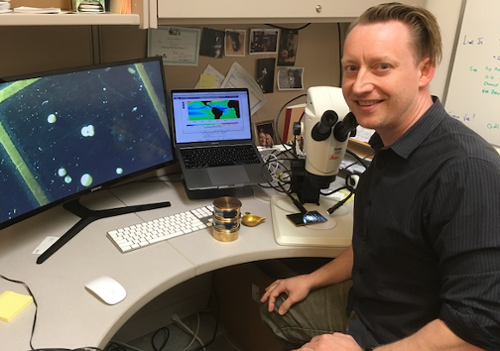Rowan research into Pacific Ocean fossils finds elusive connections to El Niño
Rowan research into Pacific Ocean fossils finds elusive connections to El Niño

A Rowan University researcher’s study, published today in the journal Nature Communications, found evidence for a close relationship between the strength of El Niño events, which alter global weather conditions, and the tropical Pacific over the last 300,000 years.
Dr. Gerald Rustic, an assistant professor of Geology within the School of Earth & Environment, said his multi-year study involved the firing of lasers at ancient fossil shells harvested from Pacific Ocean sediment samples to determine their chemical composition and, from that, the oceanic conditions from when the organisms inhabiting those shells lived.
“We studied the shell chemistry of single-celled plankton that, over time, built up on the ocean floor,” Rustic said.
Rustic and a team of scientists evaluated trace metals from more than 1000 individual shells of foraminifera, single-celled organisms the size of a grain of sand. Carefully separated by the depths in which they were found, Rustic said the shells represent 13 distinct time intervals dating back 300,000 years.
His work involved reconstructing the El Niño-Southern Oscillation (ENSO), a recurring climate pattern that changes ocean surface temperatures in the central and eastern tropical Pacific Ocean and affects weather patterns globally. El Niño and La Niña are the extreme phases of ENSO.
“During El Niño events, there is warmer than usual surface water in the eastern and central tropical Pacific, and during La Niña events it’s colder than usual,” Rustic said. “Because of these changes, the way the ocean and atmosphere interact is altered.”
He said the changing temperatures, and the reactions in the atmosphere, can lead to volatile weather conditions such as flooding in South America and droughts in Indonesia.
“We wanted to see if ENSO changed over the last 300,000 years and what drove or influenced those changes,” Rustic said. “These findings help solidify processes to better understand what’s going on. It’s a key cog in understanding, an important piece in the climate puzzle.”
Ultimately, he said, the research could help climate scientists create better models for future climate prediction by deepening their understanding of climate processes from the planet’s past.
His study, “Modulation of Late Pleistocene ENSO strength by the tropical Pacific thermocline”, published October 23.
“It demonstrates a close relationship between the warmth and depth of the eastern tropical Pacific thermocline and the strength (amplitude) of the El Niño Southern Oscillation. What’s remarkable is that this relationship we find persists across the very different climate conditions over the last 300,000 years,” Rustic said.